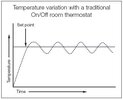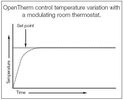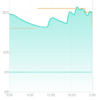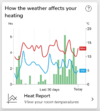Hi, I live in a small house with oil central heating. I'm trying to reduce costs. I usually only heat 1 or 2 rooms at a time, bedrrom/bathroom or bathroom/sitting room or just sitting room. Heating circulator is at medium. If I set it at the lowest speed will it increase cycling and thus wear on the boiler or is it ok? I'm trying to save money on electric (pennies I know) and also oil consumption. TRVs on the radiators and the boiler is Worcester Danesmoor WM12/19 and is currently set at the lowest heat output. I'm still early days at running everything on the lowest but at the moment it's seems to cycle more frequently. I'm just trying to work out the best setting for the relatively small space to be heated. Many thanks in advance
You are using an out of date browser. It may not display this or other websites correctly.
You should upgrade or use an alternative browser.
You should upgrade or use an alternative browser.
Central heating circulator and cycling
- Thread starter Tomc1958
- Start date
Sponsored Links
If it cuts out and restarts instead of running continuously and you are still warm, then you are saving. At a lower setting, the circulator is not clearing the heat in the heat exchanger so it cycles until return water lowers the boiler. As long as you are warm enough, boiler cycling will save you money and will not cause premature wear on the boiler.
The only thing to be aware of is that if the return temperature is too low, you may get condensation around the return port that can cause rusting.
The only thing to be aware of is that if the return temperature is too low, you may get condensation around the return port that can cause rusting.
- Joined
- 27 Jan 2008
- Messages
- 25,060
- Reaction score
- 2,907
- Location
- Llanfair Caereinion, Nr Welshpool
- Country

I have a large house, with it seems same boiler, and clearly every time the boiler fires up, it uses energy to heat the water in the boiler, but unless the boiler is outside, that energy is not wasted, it still goes into a room. We are shown graph's like this
 and told how we should aim for this
and told how we should aim for this  but our oil boilers don't have opentherm, so that is not going to happen, I look at the report from the TRV head
but our oil boilers don't have opentherm, so that is not going to happen, I look at the report from the TRV head  looks pretty, but as to helping not so sure, same with the wall thermostat
looks pretty, but as to helping not so sure, same with the wall thermostat  it looks good, but what does it tell me?
it looks good, but what does it tell me?
So the kingpin in the control is the TRV, it controls each room, and stops any room getting too hot, if the TRV closes, then the boiler will fire up, and within minutes turn off again until water in the boiler has cooled, if we however link the TRV to some hub, we can stop the boiler firing up when not required, so ideal is all linked TRV heads and a hub, but they cost, so we look at near enough engineering.
I have programmable TRV heads in 8 rooms, (9 heads) and non programmable in a further 5 rooms, and one room (upper bathroom) no control, the towel rail warms when DHW is heated. And my main problem is recovery time, that's how long it takes to reheat a room.
Theory is great, on return home, central heating fires up and also the kitchen radiator TRV increases it's setting, 10 minutes latter, the dinning room TRV follows, and 10 minutes latter the living room TRV's follow so rooms are heated in sequence, so kitchen radiator gets hot quick, but boiler does not turn off, before the others open, few hours latter the bedroom TRV's will follow.
However in practice it does not seem to work, maybe because I am running a C Plan, so also heating domestic hot water (DHW) but also the thermostat until last month was in the hall, not linked to the TRV's and clearly a TRV can't heat a room if the boiler is not running.
So in real terms, it comes down to how much you want to spend, to save a few p? I have fitted a second thermostat in the living room now, but at around £100 for the Wiser thermostat, it will ensure living room at a comfortable temperature, but will not safe me money.
So we have a battle between four controls, the water temperature, of the circulating water, the higher it is the quicker a room can heat, the lower it is the less hysteresis in the room temperature, however if the water is cool, and the room is heating slowly, the TRV will go wide open, and each Saturday at noon my TRV exercises to stop it sticking, and it takes around 4 minutes to fully open and close. This is enough time for the radiator to get stinking hot, OK once a week not a problem, but it also happens when the boiler switches off, so we have a lock shield valve to control how fast the radiator responds, this all worked A1 with a gas modulating boiler, however my oil boiler does not modulate, it simply turns off/on, also also we have a room wall thermostat fighting with the TRV for control.
What I have realised is the four houses I have lived in through my life, are all different, there is no one system suits all, my first house, gas hot air, expensive to run, but worked A1, second house also gas, this time water, open plan, so TRV's only up stairs to stop upper floors getting too hot. The next house my mothers, gas modulating boiler, and setting the TRV and lock shield valves once set each room spot on. But this house, with oil, still trying to get heating as I want it.
 and told how we should aim for this
and told how we should aim for this  but our oil boilers don't have opentherm, so that is not going to happen, I look at the report from the TRV head
but our oil boilers don't have opentherm, so that is not going to happen, I look at the report from the TRV head  looks pretty, but as to helping not so sure, same with the wall thermostat
looks pretty, but as to helping not so sure, same with the wall thermostat  it looks good, but what does it tell me?
it looks good, but what does it tell me?So the kingpin in the control is the TRV, it controls each room, and stops any room getting too hot, if the TRV closes, then the boiler will fire up, and within minutes turn off again until water in the boiler has cooled, if we however link the TRV to some hub, we can stop the boiler firing up when not required, so ideal is all linked TRV heads and a hub, but they cost, so we look at near enough engineering.
I have programmable TRV heads in 8 rooms, (9 heads) and non programmable in a further 5 rooms, and one room (upper bathroom) no control, the towel rail warms when DHW is heated. And my main problem is recovery time, that's how long it takes to reheat a room.
Theory is great, on return home, central heating fires up and also the kitchen radiator TRV increases it's setting, 10 minutes latter, the dinning room TRV follows, and 10 minutes latter the living room TRV's follow so rooms are heated in sequence, so kitchen radiator gets hot quick, but boiler does not turn off, before the others open, few hours latter the bedroom TRV's will follow.
However in practice it does not seem to work, maybe because I am running a C Plan, so also heating domestic hot water (DHW) but also the thermostat until last month was in the hall, not linked to the TRV's and clearly a TRV can't heat a room if the boiler is not running.
So in real terms, it comes down to how much you want to spend, to save a few p? I have fitted a second thermostat in the living room now, but at around £100 for the Wiser thermostat, it will ensure living room at a comfortable temperature, but will not safe me money.
So we have a battle between four controls, the water temperature, of the circulating water, the higher it is the quicker a room can heat, the lower it is the less hysteresis in the room temperature, however if the water is cool, and the room is heating slowly, the TRV will go wide open, and each Saturday at noon my TRV exercises to stop it sticking, and it takes around 4 minutes to fully open and close. This is enough time for the radiator to get stinking hot, OK once a week not a problem, but it also happens when the boiler switches off, so we have a lock shield valve to control how fast the radiator responds, this all worked A1 with a gas modulating boiler, however my oil boiler does not modulate, it simply turns off/on, also also we have a room wall thermostat fighting with the TRV for control.
What I have realised is the four houses I have lived in through my life, are all different, there is no one system suits all, my first house, gas hot air, expensive to run, but worked A1, second house also gas, this time water, open plan, so TRV's only up stairs to stop upper floors getting too hot. The next house my mothers, gas modulating boiler, and setting the TRV and lock shield valves once set each room spot on. But this house, with oil, still trying to get heating as I want it.
- Joined
- 11 Apr 2022
- Messages
- 785
- Reaction score
- 151
- Country

I don’t understand why you have such a mismatch of controls, no wonder it’s not working how you want.I have a large house, with it seems same boiler, and clearly every time the boiler fires up, it uses energy to heat the water in the boiler, but unless the boiler is outside, that energy is not wasted, it still goes into a room. We are shown graph's like this View attachment 362302 and told how we should aim for this View attachment 362303 but our oil boilers don't have opentherm, so that is not going to happen, I look at the report from the TRV head View attachment 362304 looks pretty, but as to helping not so sure, same with the wall thermostat View attachment 362305 it looks good, but what does it tell me?
So the kingpin in the control is the TRV, it controls each room, and stops any room getting too hot, if the TRV closes, then the boiler will fire up, and within minutes turn off again until water in the boiler has cooled, if we however link the TRV to some hub, we can stop the boiler firing up when not required, so ideal is all linked TRV heads and a hub, but they cost, so we look at near enough engineering.
I have programmable TRV heads in 8 rooms, (9 heads) and non programmable in a further 5 rooms, and one room (upper bathroom) no control, the towel rail warms when DHW is heated. And my main problem is recovery time, that's how long it takes to reheat a room.
Theory is great, on return home, central heating fires up and also the kitchen radiator TRV increases it's setting, 10 minutes latter, the dinning room TRV follows, and 10 minutes latter the living room TRV's follow so rooms are heated in sequence, so kitchen radiator gets hot quick, but boiler does not turn off, before the others open, few hours latter the bedroom TRV's will follow.
However in practice it does not seem to work, maybe because I am running a C Plan, so also heating domestic hot water (DHW) but also the thermostat until last month was in the hall, not linked to the TRV's and clearly a TRV can't heat a room if the boiler is not running.
So in real terms, it comes down to how much you want to spend, to save a few p? I have fitted a second thermostat in the living room now, but at around £100 for the Wiser thermostat, it will ensure living room at a comfortable temperature, but will not safe me money.
So we have a battle between four controls, the water temperature, of the circulating water, the higher it is the quicker a room can heat, the lower it is the less hysteresis in the room temperature, however if the water is cool, and the room is heating slowly, the TRV will go wide open, and each Saturday at noon my TRV exercises to stop it sticking, and it takes around 4 minutes to fully open and close. This is enough time for the radiator to get stinking hot, OK once a week not a problem, but it also happens when the boiler switches off, so we have a lock shield valve to control how fast the radiator responds, this all worked A1 with a gas modulating boiler, however my oil boiler does not modulate, it simply turns off/on, also also we have a room wall thermostat fighting with the TRV for control.
What I have realised is the four houses I have lived in through my life, are all different, there is no one system suits all, my first house, gas hot air, expensive to run, but worked A1, second house also gas, this time water, open plan, so TRV's only up stairs to stop upper floors getting too hot. The next house my mothers, gas modulating boiler, and setting the TRV and lock shield valves once set each room spot on. But this house, with oil, still trying to get heating as I want it.
Sponsored Links
- Joined
- 27 Jan 2008
- Messages
- 25,060
- Reaction score
- 2,907
- Location
- Llanfair Caereinion, Nr Welshpool
- Country

It was because Energenie and Nest lied, they said they worked together, they don't. Well at least not in a way which makes any sense.
Cycling doesn't do the slightest harm to Oil Fired Boilers, they can last up to 35 years without replacing a single item, mine is 19.
The Heatgeek and others reckon that if the cycle time is > 3 minutes then very little effect on boiler efficiency, maybe a percent or two.
The main thing to look out for in a condensing oil boiler is to ensure that the return temperature is not allowed to drop below ~ 40C to avoid corrosion problems as stated above.
I have a 19 year old, 20kw old SE Firebird with a mixture of two rads on a digital room controller and eight others with TRVs, the flowrate through the boiler seems practically constant at 10 to 12LPM, as measured by the power consumption of the Wilo circ pump.
The boiler has a 21L heat exchanger and the boiler seems to cycle very closely to the enclosed times as calculated below, I just modified the power output to 12kw and assumed the WM12/19 has a 18L HEX but this can be changed.
The Heatgeek and others reckon that if the cycle time is > 3 minutes then very little effect on boiler efficiency, maybe a percent or two.
The main thing to look out for in a condensing oil boiler is to ensure that the return temperature is not allowed to drop below ~ 40C to avoid corrosion problems as stated above.
I have a 19 year old, 20kw old SE Firebird with a mixture of two rads on a digital room controller and eight others with TRVs, the flowrate through the boiler seems practically constant at 10 to 12LPM, as measured by the power consumption of the Wilo circ pump.
The boiler has a 21L heat exchanger and the boiler seems to cycle very closely to the enclosed times as calculated below, I just modified the power output to 12kw and assumed the WM12/19 has a 18L HEX but this can be changed.
Attachments
DIYnot Local
Staff member
If you need to find a tradesperson to get your job done, please try our local search below, or if you are doing it yourself you can find suppliers local to you.
Select the supplier or trade you require, enter your location to begin your search.
Please select a service and enter a location to continue...
Are you a trade or supplier? You can create your listing free at DIYnot Local
Similar threads
- Replies
- 18
- Views
- 12K
- Replies
- 2
- Views
- 660
